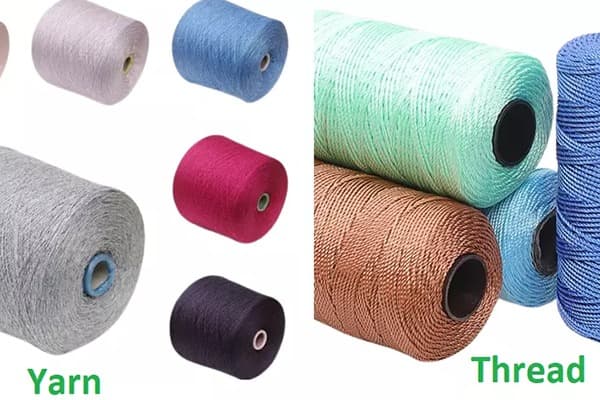As a manufacturer and supplier in the global textile industry for over two decades, my name is Allen, and I’ve seen firsthand how a simple misunderstanding can impact an entire production line. One of the most fundamental, yet often confused, distinctions is the difference between yarn and thread. For a procurement officer like Mark Thompson in the USA, sourcing materials from China, choosing the wrong one isn’t just a minor mistake—it can lead to broken needles, ruined fabrics, and costly delays. This article will unravel the core differences between yarn and thread, from their construction and materials to their specific applications. Understanding these distinctions is the first step to ensuring quality, efficiency, and profitability in any textile-based venture, whether you’re manufacturing garments or creating craft supplies.
What Fundamentally Defines Yarn vs Thread?
At the most basic level, both yarn and thread are two types of long, continuous strands of interlocked fibers, used in textile production. However, their intended purpose is where they diverge completely. Think of yarn as the building block of fabric itself. Yarn is a continuous strand of textile fibers, twisted together, primarily used to create textiles through methods like knitting, crocheting, and weaving. Its main job is to form the structure of a material, like a sweater, a blanket, or a roll of cloth. Yarn is prized for its texture, color, loft, and feel, as these qualities directly translate to the final product’s aesthetic and comfort.
Thread, on the other hand, is engineered to join fabrics together. Thread is a type of yarn that has been specifically processed to be exceptionally smooth, strong, and uniform for use in sewing machines or for hand sewing. Its primary function is utilitarian: to create strong, durable seams that hold pieces of fabric together. While color is important for matching, the paramount qualities of thread are tensile strength, resistance to abrasion, and consistency, ensuring it can pass through a needle eye and fabric at high speeds without shredding or breaking. The main difference between yarn and thread lies in this fundamental purpose: yarn creates the fabric, whereas thread assembles it.
What Are the Key Differences Between Yarn and Thread in Terms of Construction?
The functional differences between yarn and thread stem directly from how they are constructed. The process for making yarn involves taking staple fibers (short fibers like cotton or wool) or filaments (long continuous fibers like silk or polyester) and twisting them together to form a continuous strand. The amount of twist, the number of strands (plies), and the finishing process all determine the yarn's final characteristics. Yarn is a thicker, often softer, and has more texture than thread. This construction is ideal for creating fabric with specific properties like warmth, drape, or elasticity.
Thread construction, or thread involves twisting, is a more rigorous process designed for strength and smoothness. The process often starts with a high-quality yarn which is then subjected to several more steps. This can include twisting multiple strands of yarn together with a very high number of twists per inch to create a tight, strong core. The thread is then often mercerized (for cotton), gassed (passed through a flame to burn off excess fuzz), and coated with a finish like wax or silicone. This creates a thread that is thinner than yarn, incredibly strong for its size, and smooth enough to glide through fabric with minimal friction. This engineering is why a thin strand of thread can be significantly stronger than yarn many times its thickness.
How Do Material and Fiber Choices Differ Between Thread and Yarn?
While both can be made from natural or synthetic fibers, the specific materials chosen often align with their end-use. For yarn, the selection is vast and driven by the desired qualities of the final fabric. The common types of yarn include:
- Wool Yarn: Prized for its warmth, elasticity, and moisture-wicking properties.
Wool yarn is alsoexcellent for garments like sweaters and hats. - Cotton Yarn: Known for its softness, breathability, and absorbency.
Cotton yarn is madefrom the cotton plant and is apopular choice for crochet projects, summer tops, and dishcloths. - Acrylic Yarn: A synthetic option that is affordable, durable, and available in a vast range of vibrant colors.
- Blends: Many yarns combine fibers, such as a wool-nylon blend for durable socks or a cotton-silk blend for a lustrous drape.
For thread, the material choices are more focused on performance metrics like strength and durability. The many types of thread include:
- Polyester Thread: The workhorse of the industry. It’s incredibly strong, resistant to stretching and shrinking, and colorfast. This is ideal for most
sewing projects. - Cotton Thread: Softer than polyester, it’s often used for sewing lightweight, natural fiber fabrics. High-quality mercerized
cotton threadhas a beautiful sheen and is quite strong. - Nylon Thread: A synthetic
threadknown for its exceptional strength and elasticity, making it perfect for sewing heavy-duty fabrics, outdoor gear, and swimwear. - Silk Thread: Valued for its strength and fineness,
silk threadis the traditional choice for tailoring and hand finishing, as it embeds itself into fabric beautifully.
Can You Sew with Yarn or Crochet with Thread?
This is a practical question that perfectly illustrates the difference between yarn and thread. You generally cannot sew with yarn in a standard sewing machine. The thickness of the yarn and its fuzzy texture would prevent it from passing through the needle and tension discs, leading to constant jamming and breakage. Yarn is simply not designed for the mechanical stress of sewing. However, you can "sew" with yarn by hand using a large, blunt-tipped tapestry needle, which is a technique used to seam knitted or crocheted pieces together.
Conversely, you can absolutely crochet with thread. This practice is known as thread crochet. Crochet thread is a special type of thread that is mercerized for a smooth finish and high sheen. It’s much thinner than typical yarn, and it’s used with very small steel crochet hooks to create delicate and intricate items like doilies, lace edgings, and fine jewelry. While standard sewing thread could theoretically be used for crochet, it’s not ideal. It lacks the twist and finish of proper crochet thread, making it prone to splitting and resulting in a limp, lackluster fabric. The thread might work, but the experience and result would be subpar.

What Is the Significance of Yarn Count vs. Thread Count?
For B2B yarn purchasers, understanding technical specifications is crucial, and yarn count and thread count are key metrics. However, they refer to very different things.
Yarn count is a numerical value that expresses the yarn's thickness or fineness. It’s a measure of its mass per unit length. There are several systems, but a common one is the Indirect System (like Cotton Count, Ne), where a higher number indicates a thinner yarn. For example, a 20/2 cotton yarn means two strands of size 20 yarn were plied together. This system is vital for textile mills to calculate fabric weight and material consumption accurately. Selecting the right yarn with the correct yarn count is the first step in quality fabric production.
Thread count, when discussed with fabric, refers to the number of threads woven into one square inch of fabric (counting both warp and weft threads). A higher thread count generally indicates a smoother, denser, and often more luxurious fabric. When referring to the thread itself, "count" or "ticket number" is used to indicate its size. Similar to yarn count, these systems (like Tex, Denier, or Weight) help manufacturers choose a thread with the appropriate strength and thickness for a specific fabric. For example, you would use a thicker, lower-numbered thread count for denim and a finer, higher-numbered thread for silk chiffon.
Which Type of Yarn is Best for Knitting and Weaving?
Choosing the right yarn is paramount for the success of knitting and weaving projects. The best type of yarn depends entirely on the desired outcome for the final fabric.
For knitting and crocheting, the choice is often about feel and appearance:
- Wool Yarn: The natural crimp and elasticity of
wool yarnmake it forgiving to work with and perfect for creating warm, cozy sweaters, hats, and scarves. It has excellent stitch definition. - Cotton Yarn: Ideal for items that need to be absorbent and breathable, such as market bags, washcloths, and summer garments. Our durable cotton yarn is a favorite for projects that require structure and sturdiness.
- Acrylic & Blends: These are versatile, easy-care options suitable for everything from blankets to children’s clothing.
Synthetic yarn is alsoa great choice for those with wool allergies.
For weaving, structural integrity is often more important:
- Warp Yarn: The
yarnthat is stretched on the loom (the warp) needs to be very strong and smooth to withstand high tension. Plied linen, cotton, or high-tenacity polyester are excellent choices. - Weft Yarn: The
yarnthat is woven through the warp (the weft) is where creativity comes in. This can be almost anytype of yarn, from chunky, texturedwool yarnto fine, smooth silk, as it is not under tension.
What Are the Common Types of Thread for Sewing Projects?
When it comes to sewing, the choice of yarn or thread is simple: you must use thread. The type of thread used should be chosen to match the fabric’s fiber type and weight. Using the wrong thread can cause puckering seams, breakages, and long-term durability issues.
Here are some of the most common types of sewing thread:
- All-Purpose Polyester Thread: As the name suggests, this is the go-to for most projects. Our high-tenacity polyester thread is engineered for strength and is compatible with a wide range of fabrics, from cotton to knits to synthetics.
- Cotton Thread: Best
used for sewing100% cotton and other natural fiber fabrics. It has a soft, matte finish and is less likely to cause tension issues with delicate materials. We offer specialized high-fiber cone cotton thread for industrial machines that ensures smooth operation. - Heavy-Duty Thread: This is a thicker
polyester threaddesigned for sewing tough materials like denim, canvas, upholstery, and leather. - Embroidery Thread: This is a decorative
thread, often made from rayon or polyester, designed to create a beautiful sheen in embroidery patterns. It is not intended for construction seams.Metallic threadis another decorative option thatadds a touchof sparkle.

Why is Choosing the Right Yarn or Thread So Critical for Commercial Production?
In a commercial setting, the stakes are much higher than in a personal project. The decision between yarn and thread, and the specific type of each, has a direct impact on the bottom line. For a garment manufacturer, using a thread with insufficient strength can lead to seam failures and product returns, damaging brand reputation. The thread is designed for sewing under high-speed conditions, and a sub-par product will constantly break, causing machinery downtime and reducing output.
Similarly, for a weaving mill, selecting a warp yarn that can’t withstand the tension of the loom means constant breaks and flaws in the fabric, resulting in yards of unsellable material. The yarn count must be perfectly consistent; any variation can cause visible striping or banding in the final cloth. As a supplier, my role is to ensure that clients like Mark receive materials that meet exact specifications for strength, thickness, and color consistency. Understanding the differences between yarn and thread is not just a technical detail—it’s a cornerstone of quality control and operational efficiency. The yarn used in production defines the quality of the final product.
How to Select the Appropriate Yarn or Thread for Your Project?
Whether you’re sourcing for a large factory or a small boutique, here is a simple checklist for choosing the right yarn or thread:
- Identify the Purpose: Are you creating fabric (knitting, weaving)? Choose a
yarn. Are you joining fabric (sewing)? Choose athread. This is the first and most important step. - Match the Fiber: Try to match the fiber content of your
threadto your fabric. Usepolyester threadfor synthetic fabrics andcotton threadfor natural fiber fabrics. This ensures they will wear and shrink at a similar rate. Foryarn, match the fiber to the desired characteristics of the item (e.g.,wool yarnfor warmth). - Match the Weight: The
threadshould be slightly stronger than the fabric it’s sewing, but not so thick that it creates a bulky seam. Thethickness of yarnshould be appropriate for the pattern’s gauge to ensure the final item is the correct size. - Consider the Finish: Do you need a matte finish
threadthat blends in, or a high-sheen embroiderythreadthat stands out? Does theyarnneed to be smooth for stitch definition or textured for a rustic look? - Test It: Whenever possible,
sewa test seam on a scrap of your fabric or knit a small gauge swatch. This is the only way to be 100% certain that yourchoice of yarn or threadis correct before committing to the full project.
What is Speciality Crochet Thread and How is it Different?
Crochet thread occupies a unique space, blurring the lines between traditional yarn and sewing thread. Crochet thread is a type of finely spun yarn, specifically designed for the craft of crochet. It is thinner and lighter than yarn used for knitting garments, but generally thicker and less twisted than sewing thread.
The key distinguishing feature of crochet thread is its construction. It is typically made from 100% mercerized cotton, a process that makes the thread stronger, more lustrous, and better able to hold its shape. Unlike the soft, fuzzy halo of many yarns, crochet thread is smooth and sleek. It is sold in a convenient yarn ball format and is sized by a number system where, counterintuitively, a higher number indicates a thinner thread (e.g., size 10 is thicker than size 30). Crochet thread is used to create detailed, crisp lacework, doilies, tablecloths, and delicate edgings where stitch definition is paramount. It is not suitable for sewing and embroidery machines.
Key Takeaways
While they may look similar at a glance, yarn and thread are fundamentally different materials engineered for distinct purposes. Making the right choice is crucial for the quality and durability of any textile product.
- Primary Function:
Yarnis the building block used to create fabric (knitting, weaving), whilethreadis the tool used to join fabric (sewing). - Construction:
Yarnis constructed for texture, loft, and appearance.Threadis engineered for superior strength, smoothness, and consistency to withstand the rigors of sewing. - Application: You cannot
sewwithyarnin a machine, but you cancrochetwith specializedcrochet thread. - Material Matters: Choose
yarnbased on the desired qualities of the final fabric. Choosethreadto match the fiber type and weight of the fabric you are sewing. - When in Doubt, Test: Always perform a test on scrap material to ensure your
yarnorthreadchoice performs as expected.





